MOVING COIL METERS
A galvanometer deflects or measures small amount of current passing through it and it gives the direction to which that current is flowing.
In these instruments a rectangular of fine insulated copper wire is suspended in an strong magnetic field as shown in the figure below. The field is set up between soft iron poler pierces Ns attacked to a powerful permanent magnet.
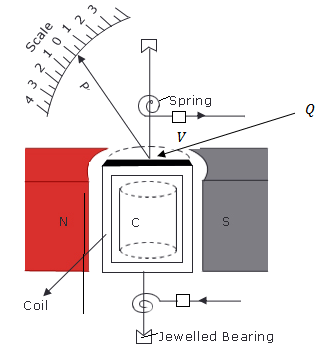
(i) Millimeter
The magnet field is radial to the core and pole pieces over the region which the coil can swing. In this case the deflected coil always comes to rest with the plane parallel to the field in which it then situated.
The moving coil galvanometer ha s has hair spring and jewel bearings. The coil is around in the rigid but light aluminium frame which also comes to carries a pivot. The current is led in and out of the springs.
Aluminum pointer P shows the deflection of coil, it is balanced by counter weight Q.
THEORY OF MOVING COIL GALVANOMETERS
The rectangular coil is situated in the radia field B when the current is passed into it the coil rotate to an angle Q which depend on the length of the spring.
No matter where the coil comes to rest, the field B in which it is situated always along the plane of the coil because the field is radial.
It is shown that the torque T of the coil is given by T = B A N I. ie.
In equilibrium the deflecting torque T is equal to the opposing torque due to the elastic forces in the springs. The opposing torque
Torque = CQ
Where C is the constant of the spring.
Example 1
A galvanometer coil has a coil has 100 turns which each turn having an area of 2.5cm2. If the coil is in the radial field of 2.0 10-9Nm per degree what current is needed to give a deflection of 600?
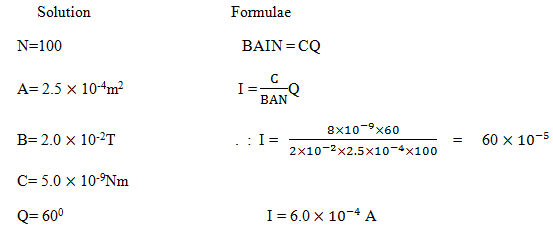
Example 2
A moving coil galvanometer with a coil of 15 turns and an area of 0.02m2 is suspended by a torsion wire which has restoring constant of 9.00 10-6Nm per degree of twist if the current of ┦MA is passed through the coil whose plane is parallel to a uniform magnetic field of 0.03T. What will be the deflection of the coil?
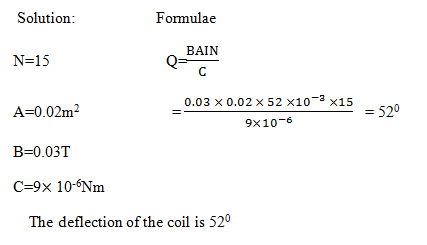
CURRENT SENSITIVITY.
Therefore the greater the sensitivity is obtained with a stronger field B atom value of c that is a week springs and greater value of N and the value of A. However the size and number of turns of a mound increase the resistance of the meter which is not desirable
VOLTAGE SENSITIVITY
If the resistance of a moving coil meter is R the p.d.v across its terminals where a current I flows it. It is given by V = IR————— (1)
But we have BAIN = C ———— (2)
Hence the voltage sensitivity depends on the resistance R of the meter.
Unlike the current sensitivity.
CONVERTING A MILLIAMETER TO AN AMMETER.
Moving coil meters give full scale deflection for current smaller than those generally met in laboratory. In order to measure the current of the order of an ampere or more we connect a low resistance s called the shunt across. The terminals of moving coil meter
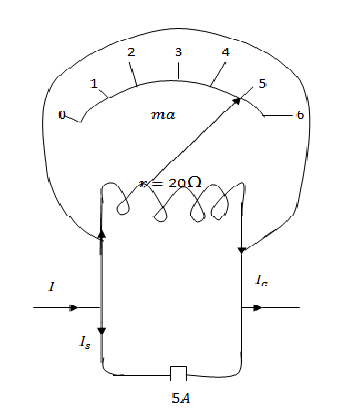
The shunt turns most of the current to be measured I away from the coil.
Suppose the coil of meter has a resistance r of 20┦ and full deflected by the current of 5MA. If we want to convert it so that its full scale deflection is 5A; Then the shunt s must be connected which will extra current that is (5- 0.005) A or 4.995A.
Potential difference across the shunt p.d across the coil ie.
Example
A milli ammeter has a full scale reading of 0.8MA and resistance of 75 ohms. What is the value of a single resistor which mould a current it into an ameter capable of reading 15amps at full scale
SOLUTION:
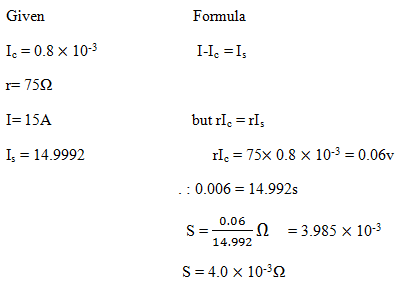
CONVERTING A MILLIAMETER TO VOLTIAMETER
Suppose we have a moving coil meter which requires 5MA for full scale deflection and also let suppose that the resistance of its coil r is 20 ┦
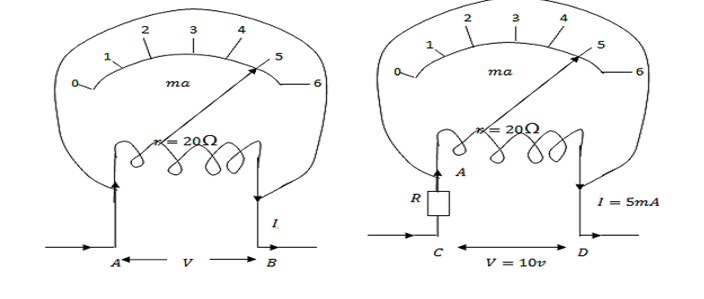
When this milliameter is full deflected the p.d across it is given by u = rI
= (20┦) (510-3)
=0.1u
If the coil resistance is constant the instrument can be used as a voltimeter giving a full scale deflection for p.d of 0.1 or 100mv so this milliameter can possess two scales for current and for voltage as shown in (1) above.
The p.d to be measured in the laboratory is usually greater than 100mv. Therefore to measure such a p.d we put resistor R in series of with the coil as shown in fig (2) above:
For example if we wish to measure to measure up 10v is applied between terminals CD then the scale current of 5MA flows through the moving coil. That is
V = (R + r) I
10 =(R + 20) 5 10-3
Or
R =2000–20
=1980┦
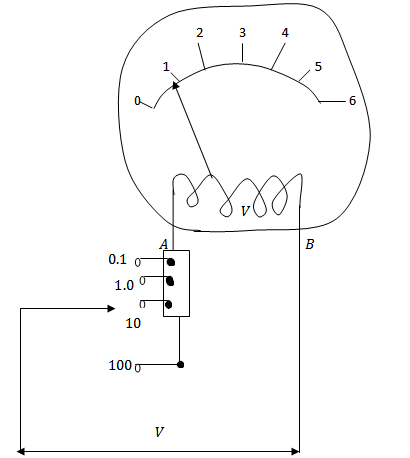
The resistance r is called a multiplier.
Many voltmeters contain a series of multiplier contains a series of multiplier of different resistances which can be chosen by a switch…. and socket arrangement shown in fig (3) above
Example
A voltmeter whose range is 0-200v has resistance R of 1500 per volt.(fsd) what resistance should be converted in series with it to give a range of 0-2000v.
Solution
Given
But when the resistance in series they have the same current through it
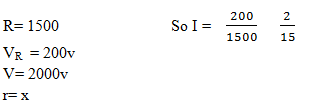
New solution:
Total resistance for this voltmeter is
=1500 200 =30 10-4┦
Total resistance for the new scale is
=15002000 = 30 105 ┦
Extra resistance required is
(30-3) 105 =27 105 ┦